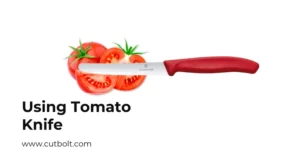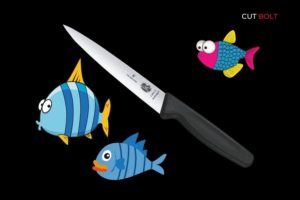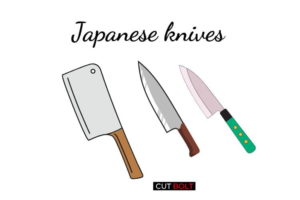We can slice, dice, carve, or even fillet with a knife. But what if I told you that there are dozens of other ways we can use a knife? We will explore them shortly.
A good knife is like a good pair of shoes— you only wear them for a short period, but they make all the difference in the world when it comes to comfort, performance, and longevity. A sharp knife is almost as important as a sharp mind. When you learn to use the right knife for each job, you can easily cut through any work with super-smooth results.
There are dozens of different types of knives out there. Which one is best for you? We present here the ultimate guide to kitchen knives.
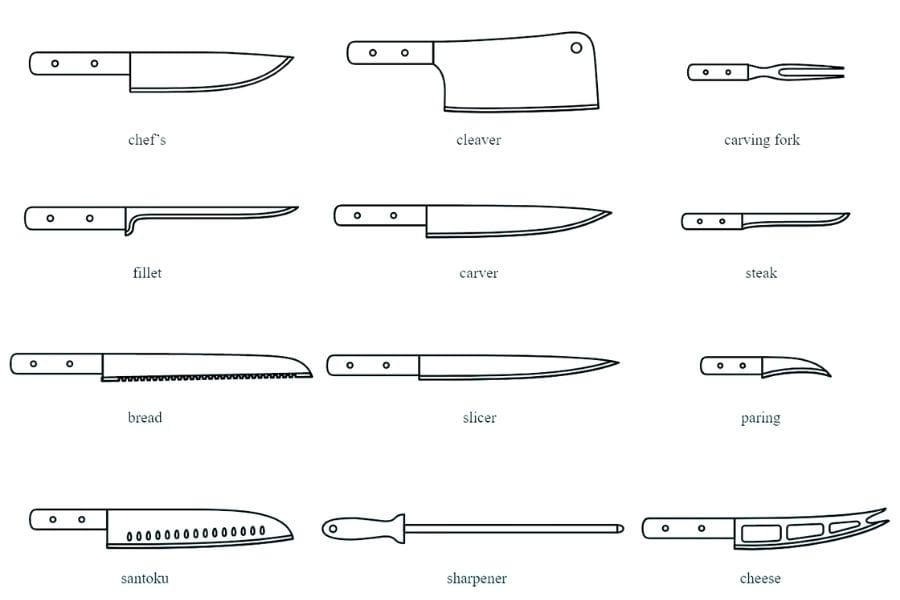
The quality and price of kitchen knives are determined by the following:
- The quality of the steel.
- The method used to transform steel into a knife.
- How sharp a knife is and how long it maintains its edge if it is handled correctly. This will depend on the 2 points above.
- How often does the knife need to be sharpened and how demanding is this process.
- The balance between the blade and the handle and how it feels in our hand.
- The quality of the mango and its manufacture.
Tips for buying quality kitchen knives
When buying quality knives, we must look at the materials with which each of the parts of the knives have been manufactured. Here are some tips to choose a good kitchen knife:
Handle of a Knife:
- Knives with wooden handles: If they are well made, the wood is very comfortable for the hands. They usually have a coating to ensure the safety of the material against splinters or porous surfaces that can damage the hands.
- Knives with rubberized handles: They are usually of very good quality. They have a soft touch, which becomes an advantage when we have to use it for a long time. When choosing it, we must make sure that the material is not porous and thus avoid the proliferation of bacteria that can nest in these pores.
- Knives with metal handles: They tend to have a balanced weight, although if we have wet hands we run the risk of slipping while we use them.
- Knives with micarta handle: They are sheets of resin and cloth or paper, which are subjected to high temperature and pressure with which a material resistant to shocks, corrosion and humidity is achieved. Check Micarta vs G10 handle.
- Knives with plastic handles: They are the cheapest, although they are not the lightest and most comfortable to use, especially when we have been working with them for a while.
- Knives with polyoxymethylene handles: It is a very resistant, hard and high quality material. Although they look like plastic knives because of their black handle, they are not.
Tang of a knife: Whatever the material, the main thing is that the design is ergonomic and with good finishes so that it has an easy grip and does not produce “pinching” in the hands during use. Another of the qualities of knives that we must also pay attention to is the way in which the blade is inserted (or better said, “encased”) in the handle.
- Knives with full tang (full tang). You can see the metal spike all the way to the end of the handle. They usually have three rivets on each side to fit the handle to the blade. These are the best quality knives, since the tang and the blade are the same piece with the same thickness.
- Knives with partial tang (half tang). They are very similar to the previous ones, although the spike only reaches the middle of the handle (sometimes a little more). You also have several rivets to hold both parts together.
- Knives with hidden tang (hidden). As the name suggests, in these cases the spike is not visible, it is fully inserted into the material of the handle. For this, the part of the metal has been worn to make it thinner and to be able to insert it.
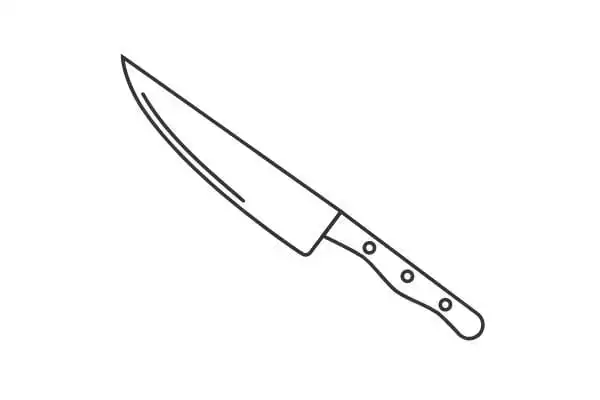
Blade of a knife: Without a doubt, one of the most important parts of the knife is the blade. Factors such as weight, balance, cutting efficiency and durability of the edge will depend on the material with which it is made. In this way, its most important qualities are cutting capacity, resistance to rust and ease of recovering the edge. For this, the quality of the steel is essential, as well as the tempering and manufacturing process.
Type of blades: Mainly, we can find two types of kitchen knife blades: stamped blades and forged blades. Stamped sheets are made by gathering various metals into shape with a tonnage press. While forged blades are made of red-hot steel, which is shaped with a hammer, either manually or with a hydraulic hammer. The former are usually cheaper.
Apart from the type of blade, the material of the blade itself is also important. In this way, we can find the following types:
- Knives with carbon steel blades: It is not very resistant to rust, so it is important to dry them very well when we clean them. Its edge is very durable and is easily achieved. Here is a guide to carbon steel knife vs stainless steel knives.
- Knives with Damascus steel blades: This is one of the oldest and strongest steels. Its edge is one of the most durable, so these knives are highly valued, also for their hardness and resistance.
- Knives with stainless steel blades: You have great hardness and a very good edge.
- Knives with ceramic blades: They have great cutting capacity, and they do not transmit flavors. However, they are delicate knives, which can break easily.
- Knives with titanium blades: Titanium is a very light and stainless material that repels bacteria.
- The comfort of use: the more ergonomic the knife, the better it will hold in your hand and will allow you to cut and chop effortlessly. It is also necessary that the knife is suitable for its use. If you only cut vegetables, you don’t need a 12-inch blade, for example.
- The balance: the balance between the weight of the handle and that of the blade is an essential element for comfort of use. Good balance will allow you to cut without much effort. It is not necessary for the knife to tilt from one side or the other, which will avoid pressure during the cut, and have faster gestures.
- The cut and hardness of the blade: for this, certain tests are carried out. CATRA tests, in particular, measure ICP (Initial Cutting Performance – immediate cut) and TCC (Total Card Cut – edge longevity after 60 uses), and Rockwell hardness tests measure the resistance of steel to impacts.
- The length of the blade: depends on how you use your knife. On the standard models you will find blades ranging from 14 to 30 cm in length. For more versatile knives, a 20 to 24 cm blade is ideal. The shape also has its importance (flat, rounded blade, etc.).
- Manufacturing methods: there are many more or less ancient techniques. A forged knife has been hot hammered to a sharp, hard blade. But today, industrial techniques predominate where the blade is cut to the pallet. If you want the best knife, choose one with a single blade and handle: the knife will be much more solid, and the weight will be better distributed.
Some of the best kitchen knife brands on the market
If you are starting in the kitchen, you are a chef and you want to know which the best professional kitchen knives are, you are in the right place. When I wanted to buy a knife, I did not have many options, due to my activities, and how crowded the stores are and the worst thing, that they do not have staffs who know their products. If you are in the same situation, you will love the following list of knife brands.
Arcos
If what you are looking for is a brand with a lot of experience in making knives: Arcos is the indicated brand in relation to Spanish knives. It has approximately 260 years of experience in the market. It is estimated that it manufactures about 600 different models of knives. It is a company that frequently invests in cutting-edge technology for the manufacture of each piece. All products are made with the highest quality standards. It is a multinational that has gained a presence in virtually all countries.
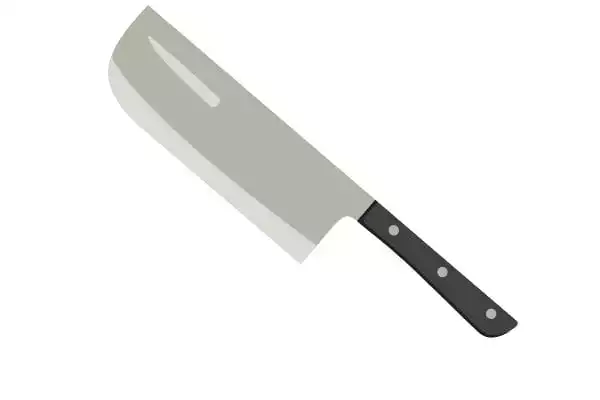
Zwlling
We all know that reputation is everything, and Zwlling has it throughout the culinary world. The focus since its inception is to guarantee quality, tradition and innovation, which together create the best results in the production of sharp, resistant and long-lasting knives. The featured models are the Twin 1731 range, which have a manufacturing process with rigorously chosen materials, using the most modern technology available. Under this modality they also designed the Zwilling Gourmet category, focused on the chef’s experience, these products are comfortable, with a soft and ergonomic grip.
Wusthof knives
This is definitely one of the most recognized German knife brands throughout the culinary industry. This company forges its knives from a single piece of German stainless steel, with a high percentage of carbon. They are so sophisticated that the cutting edge is controlled by laser. They are knives with balanced double reinforcements to achieve balance in weight and achieve cuts without effort. They stand out for their full tang, extending the length of the handle with three rivets for added security. The handle retains its edgy contoured design for a comfortable and secure grip. This brand of knives is for chefs who want to keep their knives for a lifetime.
Victorinox Knives
Victorinox is a brand that guarantees its products with the highest quality standards. The highest percentage of production of its products is carried out in Switzerland. The rest of its manufacturing abroad meets its standards, thanks to the strategy of collaborating with partners at its height. His experience with more than 130 years making the best quality knives, guarantee the production of high quality knives.
Cuisinart knives
The mission of this knife company is to offer the ability to “Savor the good life” since 1989, Cuisinart is a known name in all countries. This prestigious brand, in addition to its food processors, designs and develops knives for the culinary segment, preferred by chefs and consumers. An additional plus of this prestigious brand, consists of the series of tips and cooking techniques that they impart through their culinary education program.
Mercer Culinary Knives
Mercer Culinary is a brand that provides cutting-edge solutions for kitchens. Its foundations consider the traditional practices for making knives that chefs demand in their daily operation. Collaborate with chefs to understand current challenges and needs. The cutlery Mercer Culinary is they focused on commercial and professional culinary kitchens, quality and service earned respect; its distribution is focused on the American continent.
There are several other emerging kitchen knife brands that we have covered in our kitchen knife blog section that you can check out.
Types of handles used in knives
Wooden handles
A handle made with good wood is very comfortable and also, although wood is a porous surface, it is currently pre-treated so its use at home is not problematic.
Handles with rubberized coatings
Some grips have a good quality, soft-touch, rubberized coating. This is especially comfortable for long periods of use. But if this option is chosen, it is preferable that the material is not porous to avoid the problems that bacteria can cause.
Metal handles
There are also knives with metal handles, good looking and well-balanced weight, but they have the disadvantage that the knife can slip from a wet hand while cutting.
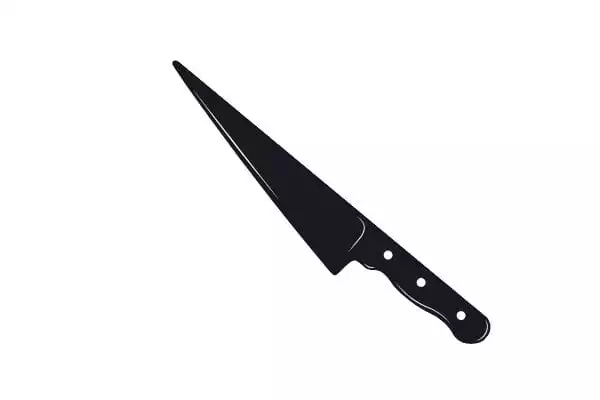
Plastic handles
Many of the inexpensive knives have handles made of plastic materials. In general, its weight is not balanced, making it difficult to use when used for a long time.
Polyoxymethylene handles
There is also a handle made of a very resistant and high hardness material called POM or Polyoxymethylene (handle in black), which should not be confused with the one used in cheap knives since this material gives it a higher quality finish than the plastic.
Micarta Handles
Currently, Micarta (Celeron or Phelonic) has also been introduced to the knife handle material options. This material is made with sheets of resin and cloth or paper, subjected to high pressure and temperature, giving rise to a material that is highly resistant to shocks , changes in temperature, humidity and corrosion in general. In addition, their designs are very versatile and original thanks to the wide variety of “mixes” that can be made.
Handles in other materials
Finally we find other materials that are used for the handle that can be of very high quality (silver and gold, deer antler, woods or exotic roots etc.). This type of finish is rare in the kitchen knife and more common in the table knife although some high-end knives such as the Japanese Shun Damascus or some of the Mac, use pakka wood.
What is suitable for all types of handles is that the shape is ergonomic to facilitate grip and that the handle has a suitable finish; since if the grip is not perfectly polished and finished, it tends to produce unpleasant “pinches” in the fingers or in the hand during its use.
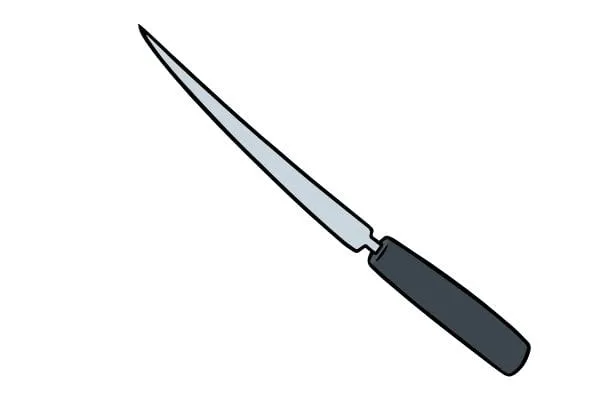
Types of tang in knives (how the blade is inserted in to the handle)
Another thing to consider about the handle is how the blade is inserted into it or what is technically known by the name of “casing”.
There is always a part of the blade that is inserted into the handle and this part is known as “rib” or “tang”. Taking into account how the spike is, there are three types of terminations:
- FULL TANG or COMPLETE TANG: In which you can see the complete metal tang up to the end of the knife handle. Generally, it will have three rivets that adjust the grips that are on both sides of the tang. Knives with these characteristics are considered of higher quality, since its tang is actually the continuation of the blade in a single piece and this is usually almost the same thickness as the blade.
- HALF TANG or PARTIAL TANG: It is a similar type in which the blade extends into the handle but only half or 3/4 of it. They also usually have 2 or 3 rivets that hold the scales on both sides of the spike.
- HIDDEN or HIDDEN SPIKE: This type of spike is not at all visible through the handle, since it is inserted into the material that composes it. Although it is the continuation of the blade in a single piece of metal, this part is worn until a thinner continuation of the material is achieved, and it can even give it the shape of a spine to improve its grip on the handle.

What materials are kitchen knives made of?
The purpose of this article is to offer you an overview of the styles and materials of kitchen knives , to help you make an informed decision when choosing the right knife and acquire one suitable for your business, or simply to equip your kitchen with the essential tools.
The first thing to consider is the type of material from which they are made.
Stainless steel knives
If you open your kitchen drawer and take a look at your knives, chances are you’ll find the brand of stainless steel (STAINLESS STEEL) printed somewhere. In fact, the vast majority of the chef’s knives are made of the same material.
What characterizes them is that:
- They are high in chromium.
- They do not present problems due to rust or corrosion.
- However, you have to take good care of them and sharpen them quite frequently.
A fairly inexpensive and durable type of knife is the high-carbon knife, which, compared to other steel knives, is quite easy to sharpen, even if you are not very experienced.
However, it has disadvantages that it is important to know before choosing:
- Stains easily.
- It rusts easily.
- It tends to leave a metallic taste in foods, especially acids (although this problem tends to disappear over time.
- After each use it must be carefully cleaned and dried before putting it away in the drawer.
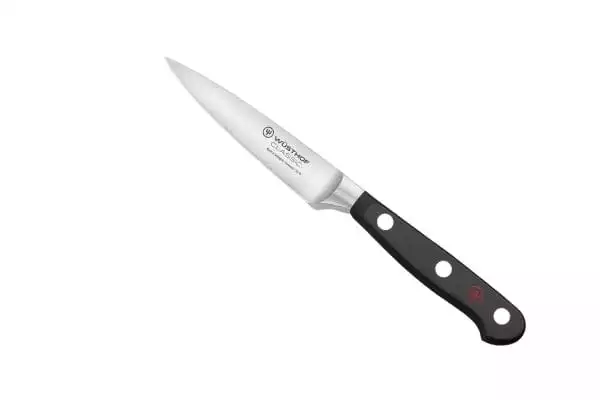
Damascus steel knives
Its name makes one dream of distant lands, customs, traditions, ethnic food … Let’s go back to reality and enter our kitchens, where Damascus knives are widely used in the preparation of the classic Italian dishes of the day to day.
What characterizes this type of knife?
- Its basic component is Damascus steel, a type of hard metal that was used in the manufacture of ancient medieval swords.
- It is a combination of at least two types of steel, which allows creating the characteristic MOLDED EFFECT of these knives.
- It is very resistant and allows even the heaviest culinary tasks.
- It maintains its sharpness for a long time, and when necessary it is easily sharpened.
Ceramic knives
The types of knives with ceramic blade have become a tool commonly used in many Italian cuisines. In fact, they are prized for a number of important advantages:
- They have an extremely hard texture, making it easy to create a sharp, carefully polished edge.
- They keep their edge for a long time.
- They are light, which is a definite advantage because you will not tire your hand if you have to prepare several dishes of meat and vegetables.
- They do not leave any flavor to food.
- They do not rust.
- They do not stain.
- They are designed to last a long time.
However, they must be handled with care because they are still ceramic and we know that this material can be damaged if you accidentally bump into something hard.
You also have to get a special tool to sharpen your blade, as the classic knife sharpener is not suitable.
Titanium Nitride Coated Knives
What immediately draws the attention of these knives is their aesthetics. In fact, they have a golden appearance, which also makes them true DECORATIVE OBJECTS.
But let’s move on to its performance in the kitchen. In reality, titanium nitride is not, as in the knives we have just described, the type of material that makes up the structure of the knife: it is a coating. It is applied as a thin layer on ceramic knives to harden and protect them. In this way:
- Extend the life of your knives even more.
- Improves cutting properties.
- It makes them aesthetically attractive.
Types of edges of kitchen knives
Kitchen knives are simple tools, but they are used every day for a wide variety of culinary tasks, and in the long run, the edge we rely on can lose cutting efficiency.
If you want to be able to trust your faithful cutting companions at all times, in addition to sharpening them regularly, it is important to learn more about their structural characteristics.
So, grab one of your knives and take a closer look. Do you see that each side of the blade has a polished edge? That edge is called BEVEL.
- Each kitchen knife bevel creates an angle that varies between fifteen and twenty-five degrees, and it is precisely this angle that must be maintained when sharpening with the proper knife steel.
- In knives, which are generally used to cut rather hard objects, this angle can vary from twenty-five to thirty degrees.
Different cutting edges require different sharpening devices and techniques, which is important to know to make sure your blades always perform optimally.
V edge
It is the classic type of kitchen knife, because it is easy to sharpen and maintains its sharpness for a long time. However, it tends to create a fairly thin edge.
Easily recognize the design of a V-edge by observing how the blades slope from the center to the edge, forming a symmetrical angle.
Double beveled edge
Also called a compound edge, it has a bevel composed of a larger V superimposed by a smaller V (called a “secondary bevel” or “relief angle”). The latter is intended to make the edge stronger and more rolling resistant and less prone to cracks.
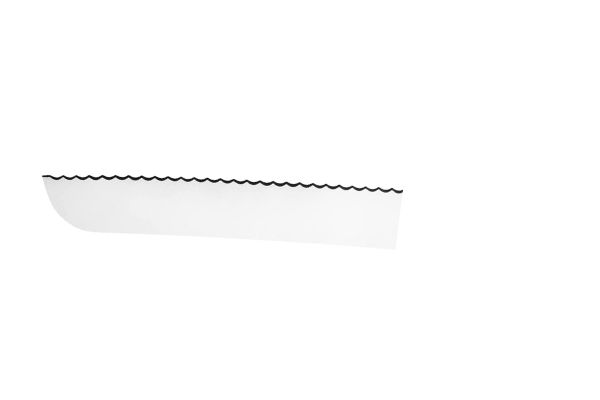
Chisel edge
Is the typical edge that can be found in Japanese tools for cutting raw fish in sushi dishes, such as the Santoku knives and Nakiri knife.
It can be easily recognized because the sharpening is present only on one side of the blade, thus forming a single primary bevel. Instead, the other side of the blade is straight and flat.
If you are left-handed and are about to buy a knife with such a blade, be careful. There are variants made especially for those who use the left hand as the predominant hand.
The sharp side usually has a sharpening angle between twenty and twenty-five degrees, which makes it extraordinarily fine and sharp, while the flat side obviously has a zero angle.
Convex edge
In this case, the leaves form two outward arches, which slope and intersect at the edge. This particular design requires a greater use of steel in the construction of the cutting edge, which makes it especially strong and sharp.
However, there is one aspect to consider: such a cutting edge requires some skill to be sharpened correctly with a household knife sharpener, since over time, if the edge is not properly restored, it tends to lose its shape.
Concave edge
To understand the structure of this edge, it may be helpful to remember our geometry classes at school. In fact, being concave, the edge curves inwards, in the opposite direction to that of the convex edges.
Apart from this, the blades are very sharp, but have a fairly limited steel content near the cutting edge, a detail that cannot be overlooked and that makes them easily prone to damage and deterioration.
You can find this type of edge on cheap kitchen knives, but if you’re on a budget, a V-edge is definitely the winning option.
Some commonly used knives in the Kitchen
As we have mentioned earlier, there are many knives and they have their own purpose. Some of the knives have special utilization. Here are some common knives that we see in most of the kitchen:
Knives for Fish & Meat
Boning Knife
The boning knife is an essential utensil in the kitchen, to cook pieces of red meat, poultry and fish. The knives Boning are manufactured with two types of blades: supple and semi. The flexible blade knife is most often used for cleaning and filleting small to medium-sized pieces, while the semi-flexible blade knife ranges from medium to large pieces.
What is the kitchen boning knife for? Its daily uses are cleaning ribs, removing bones to store meat in the freezer, cleaning poultry and fish. Remove the core of apples among other fruits. In addition to making decorative cuts.
It is made from a narrow blade. Boning knife measurements: its length ranges from 13 to 15 cm. Its flexible blade is designed to fit into tight spaces with irregular shapes in order to separate the bone from the meat. Although the leaves have elasticity, we must be careful not to bend until it breaks.
Find Resources to choose the best knives here:
Carving Knife
Carving knives are designed to cut through all kinds of cooked meat, poultry, and fish. Use a carving knife to slice a baked turkey, roast beef, slice cooked meat, and make very thin slices of smoked salmon or for a smooth, neat cut without tearing the piece of meat and keeping the juice of the food. Especially suitable for roasts and meats.
Typical measurements are between 8 and 14 inches (20 and 35 cm), and some models may have a wavy edge for use in roasts with a tougher exterior.
The Carving Fork will help you keep the product (roast, etc.) in the correct position. The arrangement of the tips prevents the meat from being damaged while it is being chopped.

Fillet knife
Along with a thin, flexible blade, the fillet knife has a handle that is often made from stainless steel or sealed wood. This makes caring for the knife a breeze. Washing it in hot soapy water will have the knife ready to use in no time. The knife can be sharpened with most types of sharpening tools, so no special care is required to keep it in top operating condition. Typically, the length of the blade ranges from 6 to 11 inches (15.24 to 27.94 cm), making it ideal for a number of different jobs, including filleting.
The length and flexibility of the fillet knife is what allows for excellent results. As an example, filleting a fish properly involves making a clean cut along the spine of the fish, entering the areas around the bones, and being able to cut the skin evenly from the meat.
Because the fillet knife is flexible and thin, the blade can easily go into places that would be impossible for a typical kitchen knife. Moving through the meat and gently separating it from the bone and skin means that much less effort is exerted and the chances of getting some usable sections are greatly increased. The result is thin, evenly sliced sections that are ready to grill, batter, fry or bake.
While the fillet knife is most often associated with filleting various types of fish, it is useful in other applications as well. For example, it can be used to shave thin sections of roast beef for baking, broiling, or pan frying. These knives also work great for cutting thin strips of chicken and meat to use in a variety of different dishes.
Whether it’s part of standard fishing and camping gear or a kitchen utensil drawer staple, it’s a handy gadget to keep on hand.
Cleaver / Butcher knife
The other name of the cleaver knife is the butcher’s knife. Don’t get frightened imagining yourself holding a big knife and cutting large pieces of meat as a butcher does.
A cleaver knife is a big rectangular-shaped knife. It is heavy and efficient in cutting meat, bones and cartilage. It can break the tendons and bones, also helps in dicing, mincing and slicing other food items.
Due to its size and cutting efficiency, a butcher’s knife can easily cut through varieties of root vegetables and squash.
While using a cleaver make sure to hold the knife properly and keep your fingers in such a position so you don’t cut them too.
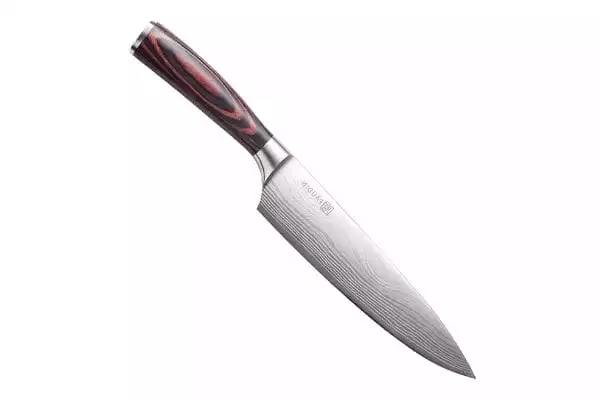
Oyster Knife
In order to open oysters with great ease, it is advisable to use oyster knives. A traditional knife is not at all suitable for opening shells. Particularly stubborn, the shells need to be opened with a blade with incredible strength. The blade of a traditional knife could deteriorate and injure you when opening. Specially designed to open oysters, an oyster knife ensures incredible efficiency and safety during use.
At the level of the blade: The blade of a professional oyster knife is short, strong and sharp at the same time. Its small size is ideal for opening shells. The criterion of robustness is essential because the shells are sometimes very tenacious and require a harder blade to open. The blade can be anti-corrosive in order to avoid its alteration. Thus, it is more resistant and lasts longer.
A comfortable handle: In an oyster knife, the handle is very important. It brings a lot of comfort, even with intensive use. It is adapted for a solid and pleasant grip at the same time. Some oyster knives are riveted: the rivets add strength to the knife so that it does not slip.
Shashimi Knife
It is a long, thin blade knife. Shashimi knife is used for filleting thinly sliced fish to prepare sashimi, cut fish and shellfish, and also to remove the skin from fish. It allows you to practice clean cuts with little force or pressure.
This knife has different versions to cut to the characteristics of each type of fish.
The Yanagiba is a knife suitable for medium-sized fish. The blade measures 21cm. at 25 cm, when it is for domestic use and those for professional use start from 25 cm. up to 36 cm. The original Yanagiba knives have a sharp blade on only one side. There is Yanagiba for right and left-handed people.
Once used, the knife is cleaned with soap and water and dries well before storing. It is recommended to use a cover that covers the entire sheet, to avoid blows.
Knife for Chef
Chef Knife
The Chef’s knife is a multi-purpose kitchen knife with a thick blade that measures between 16 cm and 36 cm. The ideal blade length for a Chef’s knife is 20 cm to easily cut larger or smaller foods. The height of the blade of a chef’s knife is generally between 4 cm and 5 cm. A chef’s knife guarantees more safety compared to other knives because its thick and high blade allows you to position your fingers correctly.
The Chef’s knife is an essential knife to have in your kitchen. Very versatile, it is suitable for cutting vegetables, fruits, meat and fish. It can also be used to finely chop, mince, slice and chop herbs.
Bread Knife
The bread knife has a rigid blade toothed in a half-moon. Thanks to its teeth, you can more easily cut the crust without risking crushing it. It allows you to cut all crusts, hard, crispy and soft breads. This one can also adapt to other foods like braised meats, and others.
You can find four types of blades in bread knives.
- Bread knives with a finely serrated blade that has teeth of different sizes.
- Bread knives with saw teeth.
- Knives with reversed teeth, that is, the rounding of the teeth is downwards and not upwards.
- Classic bread knives that has downward points.
These 4 kinds of knives cut your bread properly. However, there are a few small differences that you might find in one and not in the other.
Knives with serrated teeth cut firm, solid bread more easily, but will throw more crumbs at you.
The reversed teeth bread knife: cut is less penetrating than the others. You have to exert more pressure in order to achieve the same result.
The ideal among all is of course the knife with a finely serrated blade with teeth placed at different heights. It will give you a clean and precise edge, without difficulty. This is also the one that will produce the fewest crumbs!
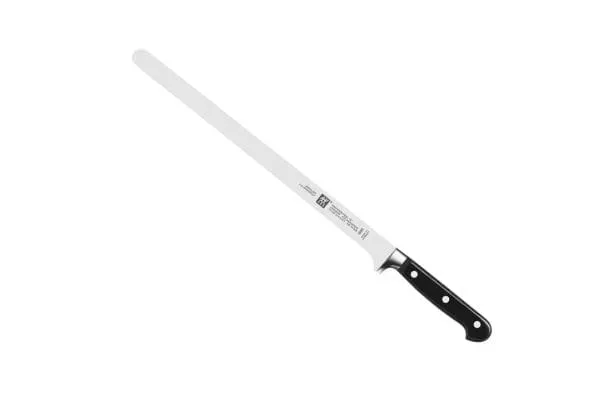
Paring knife
Precise and versatile?! That’s all a paring knife is. Indeed, with its thick blade, the paring knife cuts, peels, debones, or crushes. You can use it to cut fruits and vegetables as well as meat and fish. It cuts the strawberries for a nice seasonal pie, bones the Sunday chicken or hollows out the tomatoes and slices the mozzarella. It is THE knife to work with meticulousness. I told you it is essential in the kitchen!
The paring knife is mostly made of steel. Resistant, it can cut hard (apple, grapefruit, etc.) or frozen products. It will also help you debone poultry or crush dried fruit without worrying about breaking its blade.
In recent years, the ceramic paring knife got increasingly popular on the market. Appreciated for its maneuverability and prolonged sharpness, it is perfect for cutting any type of food. However, it is not as solid as steel.
Knife for Vegetables & Fruits
Tomato knife
The tomato knife is very useful when it comes to getting an irresistible presentation of your dishes or salads. With its saw blade you will get a clean cut through the tomato skin, obtaining very thin slices while maintaining the pulp, preventing it from falling apart or breaking.
Some models have a U-shaped tip, like a double tip; mainly it will help you when moving the slices from one place to another without breaking, which is really noticeable in case they are very thin.
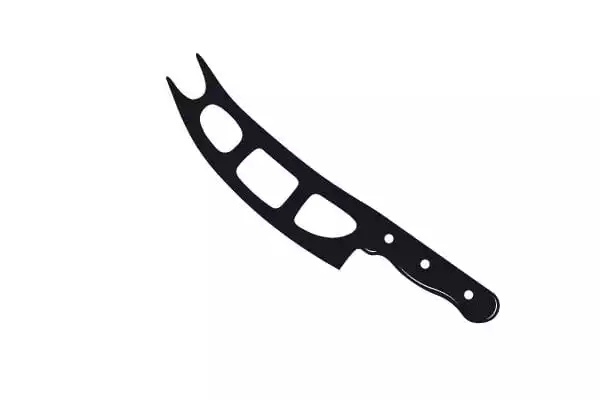
Cheese Knife
How many rules to cut a cheese correctly! What there is no doubt about is the importance of cutting it with a cheese knife: it is the best way to make the most of it and serve it as it deserves. There are several knives for different types of cheese. It is worth knowing them so that you can choose a special knife for the cheeses that you like the most.
Cheese knives, just like the bread knife, are those knives that once we try them become essential. Because? For the same reason as always, they are specifically designed to work with a material of an unstable nature and it makes us take advantage of the piece of cheese to the maximum without dirtying what is strictly necessary.
As a general rule, we can find two types of well-determined cheeses: soft and hard cheeses.
Santoku Knife
You have been hearing about the Santoku knife for years, and you have inevitably related it to Japanese gastronomic culture, but what is a Santoku knife? The Santoku Knife is a utensil of Japanese origin, which serves as a multipurpose tool, since it is used to cut both meat and fish, as well as vegetables. It can be used for most tasks in the kitchen and is a tool that should not be missing in your chef’s equipment.
All the ability of the santoku knife to function in kitchen activities makes it a worldwide recognized and replicated piece in Western culture and is brought to the kitchen of large restaurants by the most prestigious chefs.
Tomato knife
The tomato knife is very useful when it comes to getting an irresistible presentation of your dishes or salads. With its saw blade you will get a clean cut through the tomato skin, obtaining very thin slices while maintaining the pulp, preventing it from falling apart or breaking.
Some models have a U-shaped tip, like a double tip, mainly it will help you when moving the slices from one place to another without breaking, which is really noticeable in case they are very thin.
Table Knives
Butter Knife / Spread Knife
The name may already say it all, but some think that spreadable knives are only good for spreading butter on bread.
You can recognize butter knife easily. Unlike other knives, the spreader knife does not have an attached blade or a saw to facilitate cutting. All butter knives have a rounded tip, their blade is thin and wider than other kitchen knives.
Inside the cutlery of our home we cannot miss a knife to spread. If you do not have a specific one for this purpose, sooner or later you will have to buy spreadable knives.
The spreader knives are not only used to prepare a delicious toast with butter, jam or pate, they are also a good ally in the kitchen when preparing delicious dishes and exquisite desserts.
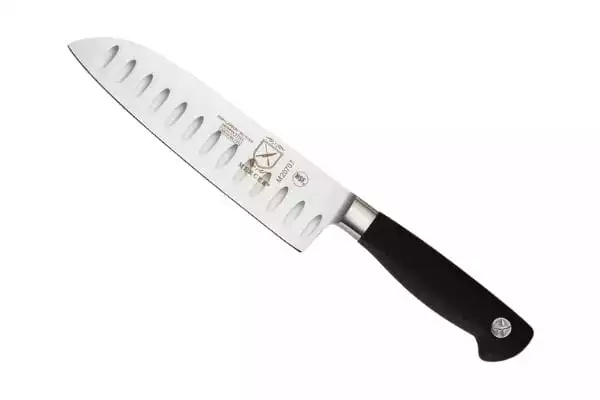
Steak Knife
If you have ever tried to cut pieces of meat on your plate with a table or butter knife, you will know how uncomfortable and complicated this can become, causing you to not even enjoy what you are going to eat. So that you don’t have to go through this, it is worth having the best steak knife at home, which will be much more useful if it comes in a set for the whole family.
Good steak knives can have blades that are completely serrated or, on the other hand, have only a part of the serrated edge, something that helps to be able to have more precision when cutting.
There are few other knives that we use in our kitchen we will discuss them in our blog section. But these are the main knives used in daily kitchen operations.
Conclusion – Ultimate guide to kitchen knives
As you can see, to choose a quality and efficient kitchen knife there are many aspects that we must look at, which at first glance can go unnoticed. However, thanks to this guide, we hope you have become an expert in kitchen knives to be able to choose the best ones for you.

